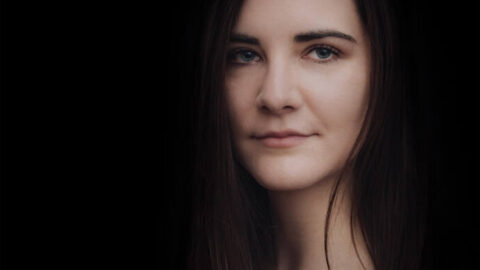If you’re a certain kind of listener, you might place Carolina Eyck’s Elegies for Theremin & Voice (Butterscotch Records) in the context of a constellation of vocalists—some more cybernetic, some less—whose stars include Pamela Z, Leslie Feist, Meredith Monk, Laetitia Sadier, and Laurie Anderson. Another kind of listener will hear Elegies for Theremin & Voice as an instantiation of the virtuoso composer-performer’s bravura, more in line with Paganini, Keith Jarrett, or the 19th-century doyens of the Paris Conservatoire. A third kind of listener—the kind who steers away from such lazy and obviously gendered typologies; the kind to which we should all aspire—will find Elegies for Theremin & Voice very impressive, a little mysterious, and wholly enjoyable.
Here’s an observation that sounds utterly ignorant but whose implications are so remarkable that one has to offer it up anyway: Eyck plays the theremin like a normal instrument. Nowhere on Elegies for Theremin & Voice appear the irregularities in tuning or rhythm for which a performance on the theremin would be quickly forgiven. Eyck’s control of the instrument is surgical, a feat which is not only impressive on its own but also serves to heighten the contrast between the theremin and Eyck’s voice—an accurate and handsome voice, certainly, but neither a bel canto voice nor an incredible modern instrument in its own right: a human voice, an earthly voice, to counterbalance the famously unearthly theremin. (“Presence” affords Eyck the opportunity to explore a variety of vocalisms whose gesticulations threaten to dilute the thesis of the record; to my ear, it might be a piece better suited to a context other than Elegies.)

For a collection of pieces that only involve theremin and voice, Elegies shows a startling variety throughout. Gothic, almost Castlevanian embellishments abound—on “Friend,” for example, vocal ostinato gives way to an increasingly claustrophic chorale before making a phantasmal reappearance. The striking accretion of voices in the middle of “Friend” is a highlight of the album, matched by the grand gesture (or perhaps the grand texture) that concludes “Commemoration.” Such generous swaths of sound are often balanced on the edge of the sublime and the terrifying: as Eyck populates a limited registral space with denser and denser chromatic bands, a pillowy sound environment in which we may want to lie down and luxuriate turns subtly and eerily into a kind of aural coffin. “Solo I,” “Solo II,” “Duet I,” and “Duet II,” on the other hand, challenge us to extract cohesive affective meaning from them: these gnomic aphorisms were my favorite pieces on the record. At the risk of armchair advising, an enterprising young thereminist could probably wring a grad-level music theory seminar paper from a close reading thereof. I’d read it.
One imagines that only a performer like Eyck, who has both a formidable facility with the theremin and the inclination to pair it with her voice, would structure the album’s material the way she has. Sometimes the voice is in the foreground, sometimes the theremin; sometimes the theremin seems to wail like a voice, and sometimes the voice seems to sit at attention like the theremin. The theremin becomes a voice, in a sense (and not only in the superficial sense that it kind of sounds like one): this coterminosity of electronic instrument with live performer is a post-humanity I can get behind.
























